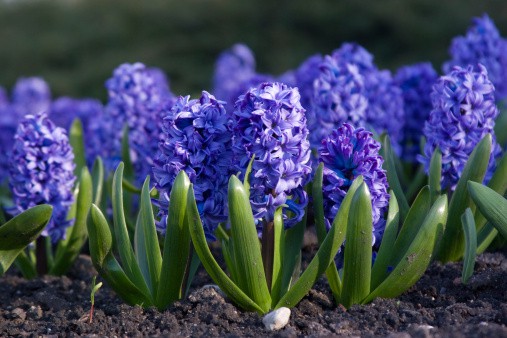The Greek name for Hyacinthus orientalis, “Hyakinthos”, is derived from the story of a young beautiful man who was beloved by both Apollo and Zephyr. When the West Wind God killed him with a discus, Apollo transformed Hyacinthus into the flower we know today.
How to Plant
Planting and growing Dutch Hyacinth is a relatively straightforward task. This type of bulb needs well-draining soil, so adding organic matter and sand or peat is key. Hyacinthus orientalis prefer full to partial sun, and a slightly acidic soil with a pH of 6.0-7.0. When planting the bulbs, it’s best to dig a hole six inches deep and place bulbs at least three inches apart. Water your Dutch Hyacinth after planting and make sure to water the plants regularly (up to 2-3 times per week).
Meaning and Symbolism
Dutch Hyacinth makes a great addition to almost any bouquet or garden due to its colorful petals and lovely scent. The beauty of these flowers stands for rebirth, renewal and awakening. Hyacinthus orientalis is a reminder of spring and of everything the season symbolizes: hope, the joy of new beginnings, and the beauty of nature coming alive again.
History, Mythology, and Religious Significance
From its mythical roots to its timeless symbolism, Dutch Hyacinth has held a special place in human culture. The story of Hyakinthos can also be found in early Christian lore, and this flower became a beloved symbol of resurrection, a flower of Easter. A cross made of Hyacinths is a common decoration on Christmas Day to remind people of the deep meaning of Easter.
Flower Varieties and their Defining Characteristics
Hyacinthus orientalis come in a variety of colors, including white, pink, yellow, purple, blue, and even black. Some common varieties of Dutch Hyacinth are: the White Sunray, the Baby Bells, the Purple Oxalis, the Blue Magic and the Pink Sunrise. Depending on the variety, the flowers can grow anywhere from 6 inches to 4 feet tall and high. The flowers contain 4 petals and make a beautiful addition to any garden.
How to Pot and Repot
When planting Dutch Hyacinths in containers, make sure to use large and deep pots that are well-draining. The soil should also be properly drained and fertilized. Repotting can be done when the old pot has become crowded and the bulbs start to root out of the container. Use lightweight potting mix with crushed bark and Vermiculite for best results. When repotting, make sure to water the bulbs well.
How to Prune
When pruning Dutch Hyacinths, always use sharp, clean tools to avoid damaging the plant. Start by cutting off the flowered stems, taking care not to damage the new emerging buds. Once the flowers have faded, trim away the withered leaves and dispose of them. Pruning will help the bulbs to focus their energies on producing new flowers and provide a neat and tidy appearance.
How to Propagate
Propagating Dutch Hyacinths is a simple and cost-effective way to increase your stock of plants. Dig up the bulbs in the springtime and carefully remove some of the small offshoots, called “bulblets”. These offshoots can be planted in pots or in the ground. You can also divide large bulbs into several smaller ones and replant them as needed.
Common Pests and Diseases
Like all types of plants, there are various pests and diseases that can affect Dutch Hyacinth. Common pests include aphids, caterpillars, thrips, and snails. To avoid infestations, regularly inspect the plant and pluck out any visible pests. Common fungal diseases include rust and powdery mildew, as well as bacterial soft rot and tulip fire. To help prevent fungal diseases, it’s important to plant your Dutch Hyacinth in well-draining soil and avoid overwatering.
Frequently Asked Questions
Q: What is the lifespan of Dutch Hyacinth?
A: Dutch Hyacinths are generally short-lived, with a typical lifespan of one to three years. But with proper care and a healthy environment, they can live longer.
Q: How often should I water my Dutch Hyacinth?
A: The amount of water your Dutch Hyacinth needs will depend on the weather and other environmental factors. Make sure to water your plants regularly in dry conditions and lightly in wet weather. Remember to avoid overwatering, which can lead to fungal diseases.
Q: How can I prolong the blooming stage of my Dutch Hyacinth?
A: Deadhead the plants regularly, which will help encourage new blooms and prolong the flowering period. In addition, prune wilted flowers and leaves, andamp; make sure to fertilize during late winter or early spring.
Fact Sheet
| Plant | Details |
|---|---|
| Hyacinthus Orientalis | Family: Asparagaceae Plant Type: Perennial Mature Size: 6-24″ tall Sun Exposure: Full to partial sun Soil Type: Well-drained Soil pH: 6.0-7.0 Bloom Time: Mid/late spring Flower Color: White, pink, yellow, purple, blue, black Hardiness Zones: 3-7 Native Area: Mediterranean countries |
What we love from Amazon this week
Buy these wonderful flowers directly from Amazon:















